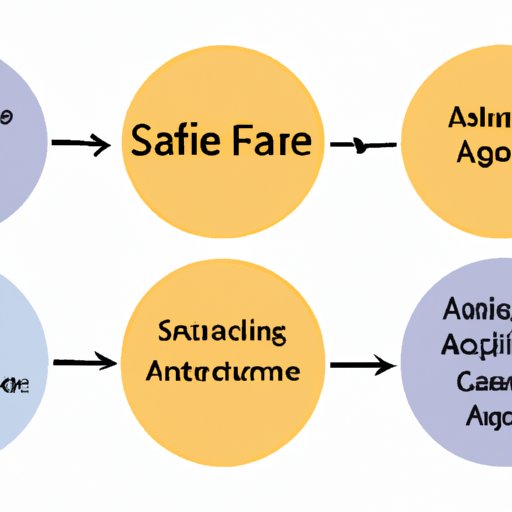Introduction
Agile software development has become a popular methodology for delivering high-quality products efficiently and effectively. However, as projects and teams grow, agility alone may not be enough to meet the increased complexity and scale of development. Safe agile, or Scaled Agile Framework, is a proven methodology that emphasizes not only agility but also safety, stability, and predictability for large-scale software development. In this article, we will explore safe agile principles, practices, and frameworks to help organizations and teams achieve successful outcomes that balance agility and safety.
“10 Principles for a Safe and Secure Agile Process”
Safe agile is built upon ten principles that ensure a safe and secure process for large enterprises, complex systems, and distributed teams. These principles help teams establish a common language, synchronize work, deliver value, and improve continuously. Here are the ten principles for safe agile:
1. Take an economic view
2. Apply systems thinking
3. Assume variability; preserve options
4. Build incrementally with fast, integrated learning cycles
5. Base milestones on objective evaluation of working systems
6. Visualize and limit work in progress, reduce batch sizes, and manage queue lengths
7. Apply cadence (timing), synchronize with cross-domain planning
8. Unlock the intrinsic motivation of knowledge workers
9. Decentralize decision-making
10. Organize around value
Each principle is essential for a safe agile process and contributes to creating an environment of trust, empowerment, transparency, and collaboration. Let’s discuss them in more detail.
Take an economic view
Taking an economic view means that everyone in the organization understands how the work they do contributes to the economic success of the company. By adopting lean thinking and optimizing for the entire value stream, teams can focus on delivering value, minimizing waste, and maximizing return on investment.
Apply systems thinking
Systems thinking means understanding how the parts of a system interact with each other and how they contribute to the system’s overall purpose. By taking a holistic approach to software development, teams can optimize the flow of value by removing bottlenecks, reducing handoffs, and improving communication.
Assume variability; preserve options
Variability is inherent in software development, and teams need to embrace it by preserving options and deferring commitment until the last responsible moment. By using hypothesis-driven development, frequent testing, and feedback loops, teams can learn faster and adapt to changing requirements and conditions.
Build incrementally with fast, integrated learning cycles
Fast, integrated learning cycles are essential for delivering value early and often. By embracing iterative, incremental development and continuous integration, teams can reduce risk, improve quality, and increase customer satisfaction.
Base milestones on objective evaluation of working systems
Objective evaluation of working systems means using data and measurement to validate assumptions, provide feedback, and adjust course. By using frequent inspections, retrospectives, and reviews, teams can ensure that they are delivering what the customer needs and wants.
Visualize and limit work in progress, reduce batch sizes, and manage queue lengths
Visualizing work in progress means making the work visible and transparent to everyone in the organization. By limiting batch sizes and managing queue lengths, teams can reduce cycle time, improve flow, and increase efficiency and productivity.
Apply cadence (timing), synchronize with cross-domain planning
Cadence means working in fixed timeboxes and hitting predictable milestones. By synchronizing cross-domain planning, teams can ensure alignment, minimize friction, and maximize throughput and predictability.
Unlock the intrinsic motivation of knowledge workers
Intrinsic motivation means doing work that is fulfilling and rewarding in itself. By providing purpose, autonomy, and mastery, teams can unlock the full potential of knowledge workers and inspire them to achieve greatness.
Decentralize decision-making
Decentralized decision-making means empowering teams and individuals to make decisions based on their knowledge, expertise, and context. By distributing decision-making authority, teams can reduce bureaucracy and increase agility and innovation.
Organize around value
Organizing around value means focusing on delivering value to the customer, rather than on optimizing for individual departments or functions. By creating cross-functional teams, aligning around a common vision, and measuring outcomes, teams can ensure that they are delivering value that matters.
“A Comprehensive Guide to Safe Agile Frameworks”
Safe agile frameworks provide a structured approach to implementing safe agile principles at scale. There are several safe agile frameworks available, each with its own advantages and disadvantages. Here are three of the most popular frameworks:
SAFe (Scaled Agile Framework)
SAFe is the most widely adopted safe agile framework, with a comprehensive set of roles, practices, and ceremonies that help organizations achieve alignment, transparency, and frequent feedback. SAFe is particularly suitable for large enterprises that need to coordinate multiple teams, manage complex systems, and integrate with external partners. SAFe includes several core elements, such as the Lean-Agile mindset, the Agile Release Train (ART), Portfolio and Program Kanban systems, and Continuous Delivery Pipeline.
LeSS (Large-Scale Scrum)
LeSS is a framework that applies Scrum principles and practices to large-scale software development. LeSS emphasizes simplicity, customer focus, and cross-functional teams, and offers two variants, Basic LeSS and LeSS Huge, depending on the number of teams and products involved. LeSS provides a set of rules, guides, and experiments for scaling Scrum, such as joint product backlog, overall retrospective, and area product owners.
Scrum@Scale
Scrum@Scale is a framework that extends Scrum to tackle complex problems at scale. Scrum@Scale is a lightweight framework that enables organizations to rapidly implement agile practices, share knowledge, and improve continuously. Scrum@Scale operates through three core components, the Scrum Master Cycle, the Product Owner Cycle, and the Scale Cycle, which help teams optimize their work, streamline their processes, and scale their solutions.
Each framework has its own strengths and weaknesses, and choosing the right framework depends on several factors, such as the organization’s size, complexity, culture, and goals. Organizations should evaluate each framework carefully and select the one that suits their needs best.
“Navigating the Waters of Agile Safely: Best Practices for Teams”
Safe agile implementation requires a team effort that involves adopting best practices, overcoming challenges, and improving communication and collaboration. Here are some best practices that teams can follow to ensure safe agile implementation:
Establish a clear product vision and roadmap
A clear product vision and roadmap help teams align around a common goal, communicate effectively, and track progress. By using visual tools, such as product backlogs, story maps, and roadmaps, teams can create a shared understanding of the product and its features and prioritize their work accordingly.
Create cross-functional teams that align around value
Cross-functional teams bring together individuals from different disciplines, skills, and backgrounds to work collaboratively on delivering value to the customer. By organizing around customer-centric value streams and using agile practices, such as Scrum, Kanban, or XP, teams can enable rapid feedback, minimize waste, and increase quality and innovation.
Embrace continuous integration and delivery
Continuous integration and delivery mean integrating, testing, and deploying changes frequently and automatically. By adopting DevOps practices, such as infrastructure-as-code, automated testing, and deployment pipelines, teams can reduce risk, increase speed, and improve reliability and scalability.
Practice effective communication, transparency, and feedback
Effective communication means sharing information openly, honestly, and frequently. By using visual management, daily stand-ups, retrospectives, and demos, teams can create a culture of transparency, trust, and collaboration that fosters innovation and continuous improvement.
Monitor and improve team health and productivity
Team health and productivity mean ensuring that the team is happy, motivated, and performing at their best. By measuring and tracking team metrics, such as velocity, quality, cycle time, or burnout, teams can identify areas of improvement, address issues early, and celebrate successes.

“The Top 5 Tips for Ensuring Safe Agile Implementation”
Here are the top five tips for ensuring safe agile implementation:
Start small and iterate
Start with a pilot project or a small team and test the waters before scaling up. By iterating frequently and incorporating feedback, teams can learn faster, reduce risk, and achieve better outcomes.
Focus on customer value
Focus on delivering value to the customer, not just on completing tasks or milestones. By involving the customer in the development process, teams can ensure that they are delivering what the customer needs and wants.
Empower the team
Empower the team to make decisions, solve problems, and continuously improve. By providing autonomy, mastery, and purpose, teams can be more creative, innovative, and engaged.
Celebrate successes and failures
Celebrate successes and failures equally, and learn from them. By recognizing and rewarding progress, teams can motivate themselves to do better. By embracing failure and encouraging experimentation and learning, teams can become more resilient and adaptive.
Continuously improve
Continuously improve by incorporating feedback, reviewing practices, and experimenting with new ideas. By adopting a growth mindset and focusing on continuous learning, teams can stay ahead of the curve and achieve excellence.
“Avoiding Common Pitfalls in Agile Implementation for Safe and Effective Teams”
Despite the benefits of safe agile, teams may encounter some common pitfalls during implementation that can impede progress and effectiveness. Here are some common mistakes and how to avoid them:
Copying others’ practices without adaptation
Copying others’ practices without adaptation means blindly applying best practices without considering context, culture, or goals. This can lead to a lack of ownership, engagement, and results. Instead, teams should experiment, learn, and adapt practices to fit their specific needs.
Emphasizing process over people
Emphasizing process over people means valuing rules, procedures, and tools more than individuals, interactions, and outcomes. This can lead to a lack of creativity, innovation, and engagement. Instead, teams should focus on creating a culture of trust, empowerment, and collaboration that fosters ownership, creativity, and innovation.
Ignoring team health and happiness
Ignoring team health and happiness means prioritizing output and productivity over the well-being and satisfaction of team members. This can lead to burnout, turnover, and low morale. Instead, teams should monitor and improve team health and productivity by measuring and addressing factors that affect engagement, motivation, and satisfaction.
Not aligning with business goals and values
Not aligning with business goals and values means developing products and services that don’t match customers’ needs and expectations or violate ethical, social, or environmental standards. This can lead to a lack of trust, reputation damage, and legal issues. Instead, teams should align with business goals and values by involving customers, stakeholders, and society in the development process and adhering to relevant standards and regulations.
Not fostering a learning culture
Not fostering a learning culture means avoiding feedback, reflection, and continuous learning. This can lead to complacency, stagnation, and suboptimal performance. Instead, teams should embrace learning as a core value and practice by seeking feedback, reflecting on their practices, and experimenting with new ideas.
“Safe Agile in Practice: A Case Study of Successful Implementation”
Case studies provide real-world examples of how safe agile can work in practice and what benefits it can bring to organizations and teams. Here’s a case study of successful implementation of safe agile:
Company X
Company X is a Fortune 500 company in the financial services industry. Its IT department had been using traditional project management methods that resulted in long lead times, low predictability, and high costs. To improve its competitiveness, the IT department decided to adopt safe agile practices.
